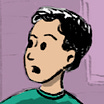My Seven-Year-Old Daughter Asked Me to Make Her a Video Game
Mobile developer Quinn Stephens was recently given a surprise task by his child, and rather than brushing it off, Quinn is trying to make it work.
Hi all, I’m on vacation this week, but I’m pleased to present two guest posts while I’m on the beach with family. I’m open to more pitches at Crossplay, even from writers without bylines. I’m more interested in life experience than work experience. Drop me an email. -pk
“Dad, can you work on my game?”
“In a bit, Mezzie. I’m working.”
“Ugh, dad…”
“I have to work now, kiddo! It’s my job!”
I’m lying. I am, in fact, working, but not at my job. It’s after work hours and I’m making my own game, for the Playdate. And I’m wracked with guilt.
A few months ago, my seven-year-old daughter Esmeralda (nicknamed Mezzie) had a brilliant idea. Could I make her a video game? I was thrilled. Years ago, I was a full-time indie game developer, and while I’ve since moved on to business-focused software engineering, I still tinker with game dev in my spare time. Both Mezzie and her four-year old sister Violeta love playing with these hobby projects, and I love seeing their reactions. What could be better than to combine my experience with my daughter’s childhood enthusiasm?
What could be better, in her mind, was for me to just make the game for her, while she went back to playing Minecraft. I pushed her to make sketches, write out descriptions of the mechanics, and generally help me understand her vision. But like most children, she’s very enthusiastic about her ideas, and much less jazzed about doing any work to make them happen.
I recalled when my wife and I first started talking seriously about having kids. Becoming a parent is scary for everyone, but for creative people with day jobs, it comes with an extra layer of fear: where will I find the time and energy for my art? What if I can’t? That worry made me genuinely ambivalent about parenthood. What finally convinced me was the realization that I could do fun art projects with my kids. It didn’t have to be a zero-sum game.
Of course, I hadn’t met my daughter yet.
Mezzie is a wonderful kid; she’s a bright, funny, voracious learner who pores through books of trivia and peppers us with questions about the world. She has a genuine knack for architecture, whether she’s using magnet tiles or playing a sandbox video game. She’s also strong-willed, ambitious, and determined to get what she wants—qualities that will serve her well in adulthood, but as any parent reading this knows, help precisely no one when she refuses to turn off the TV to go take a bath. She was, right from the start, the toughest client I’d ever had.
Mezzie had a complete vision for her game and wasn’t interested in my feedback. She didn’t know (or care) what made a hobbyist game different from a AAA flagship release; my pitch for a simple pixel-art retro game was quickly shot down. She wanted a 3D-rendered environment with characters as expressive and detailed as the ones in Astro’s Playroom. And a character creator with as many options as Dreamlight Valley. And a house-building minigame. Oh, and she wanted to play online with her friends, which she isn’t even allowed to do yet.
The worst part is, I almost agreed to this stuff. I don’t really know 3D modeling, but I’ve been meaning to give Blender another try, and there are tons of Godot tutorials, and I know people who’ve designed network games, and…it was hard to say no. I spend so much of my day telling her “no” to candy, or screen time, or skipping school, that I want to be as open-minded as possible to her big creative ideas. And if I’m being honest, I also want to be the cool dad who can do everything.
“I sigh. Mezzie won’t be a kid forever, and even if collaborating with her is more frustrating than thought it would be, the grin on her face when she finally plays the game will be worth it.”
But I can’t do everything. After explaining that, I was finally able to talk her down to a feasible goal. No pixel art, but 2D art was acceptable, and we’ll just have one player character for now. So we got to work on Escape the Disasters, in which players navigate out of the woods during a windstorm, and then outrun a raging wildfire with the help of trampolines. The third level involves designing and building a base, but we’ll cross that bridge when we get there.
Progress has been slow. My kids already take up most of my non-job time, and I still want to put some of that time into my own projects. Which is why I’m sitting here, staring guiltily at the code for my Playdate game and pretending it’s for work.
I sigh. Mezzie won’t be a kid forever, and even if collaborating with her is more frustrating than thought it would be, the grin on her face when she finally plays the game will be worth it. Someday I’ll find a way to keep all these plates spinning, right? I close my project and open up the player sprite for Escape the Disasters.
Then I hear footsteps behind me. I turn expecting Mezzie, but it’s Violeta. She fixes me with a frown. “Dad, what about my game?”
Quinn Stephens likes to tell stories and create visual art, often at the same time, which has resulted in a number of short movies, video games, and other stuff that’s increasingly hard to categorize. You can learn more about Quinn’s work on his website.






